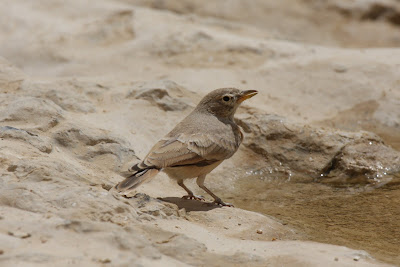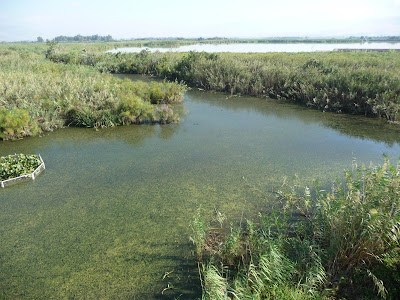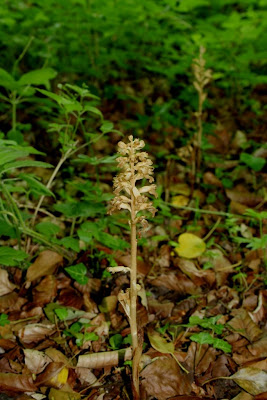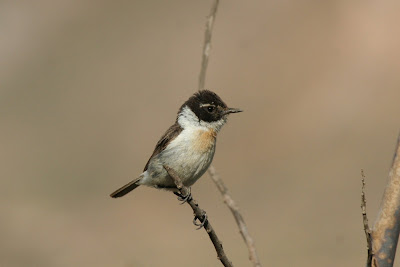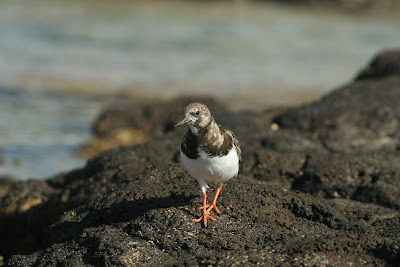
Useful advice...
Got to spend another 10 days in Israel between 4th and 13th September 2009. My wife was again helping out with a Palaeolithic excavation in the Hula valley and I tagged along for the ride. Essentially I spent 90% of the time out birding, the rest was spent helping at the dig site and doing more touristy activities. Huge thanks once again to Gonen Sharon and colleagues from the Hebrew University of Jerusalem for providing accommodation, food and good company at Gadot and for the experience of digging up bones and stones.


4th September 2009
First stop was En Avdat National Park, close to Ben Gurion’s home and grave. En Avdat is a spectacular gorge cut out of limestone, with horizontal veins of the blackest flint running through – a geologist’s dream. At the entrance gate (where we purchased a fantastically good-value-for-money multi-entrance ticket to the INRPA sites) there was a single Mourning wheatear perched on the barbed wire and a little further down the track we came across a party of three Green bee-eaters lined up on a fence plus more Mourning wheatears – a good start to the visit and two new birds for me!
We entered the park itself and in a small grove of acacia and tamarisk bushes at the car park we found Blackstart – an incredibly bold and tame species. The walk along the (already baking) gorge revealed many tutting and chacking sounds emanating from the shrubs and boulders – certainly several Eastern olivaceous warblers were present as well as Graceful warblers, Blackstarts and Mourning wheatears. Following the small stream bed through the gorge brought us out at a small waterfall and pool with some stands of rush. The pool was buzzing with Lesser emperor dragonflies Anax parthenope and an unidentified darter Sympetrum species. The water also contains a population of freshwater crabs! Moorhens were also in abundance.
We entered the park itself and in a small grove of acacia and tamarisk bushes at the car park we found Blackstart – an incredibly bold and tame species. The walk along the (already baking) gorge revealed many tutting and chacking sounds emanating from the shrubs and boulders – certainly several Eastern olivaceous warblers were present as well as Graceful warblers, Blackstarts and Mourning wheatears. Following the small stream bed through the gorge brought us out at a small waterfall and pool with some stands of rush. The pool was buzzing with Lesser emperor dragonflies Anax parthenope and an unidentified darter Sympetrum species. The water also contains a population of freshwater crabs! Moorhens were also in abundance.
Bird species encountered along the path were a noisy and active group of Tristram’s starlings, two cruising Griffon vultures and a party of three Desert larks slaking their thirst in a small pool. Also present were a small group of Rock martins, flitting about the upper levels of the gorge walls.
Leaving En Avdat when it really got too hot (35°C) we continued south to arrive at Kibbutz Lotan in the late afternoon. The route through the Arava is exceptionally bleak for someone used to the lush greens of Britain – the landscape is generally beige, dusty and with only the occasional acacia shrub or palm plantation to break the monotony. Bird species spotted along the way were Brown-necked raven and Chukar.
After a much-needed siesta we had time to take in our surroundings a bit more and make a judgement on the place. I have to say I was underwhelmed with Lotan – the website gives the impression that the place is a Mecca for birders and is well equipped to accommodate them. Our experience was that this was maybe true several years ago but there is very little in the way of birder-orientated facilities for late summer visitors. True, there is a small ‘bird reserve’ but the signage is so faded as to be unreadable, there is no sightings board and the reserve had virtually no birds in whatsoever, presumably due to the complete absence of any water in the ponds. The organic gardens mentioned in Shirihai are gone, now replaced by a goat farm – is Lotan living on a reputation? Maybe...
Over the two days there (in good, clean accommodation it must be said) we added Barn swallow, Yellow-vented bulbul, Palestine sunbird, Hoopoe, House sparrow, Red-backed shrike, Yellow wagtail, Blackcap, Spotted flycatcher, Pallid swift and Spur-winged plover as well as additional Collared and Laughing doves and Rock martins.
5th September 2009
A really enjoyable day. Started the morning with a reasonable breakfast at Lotan and then drove a short way south to Hai-Bar Yotvata Biblical Wildlife Park. Despite the name, this place is a serious venture entailing a laudable effort to re-introduce a number of large herbivorous mammals (and one large bird) previously extirpated from the Arava.
The site contains two activities – a walk taking you past enclosures, pens and tanks containing the typical desert fauna of the Arava including beautiful Leopards, Striped hyenas, Caracals, Wolves, Jackals, smaller cats, porcupines, numerous small furry things such as gerbils, snakes, lizards, tortoises and birds. The latter group comprises Eagle owl, Kestrel and Egyptian, Griffon and Lappet-faced vultures (the ugliest bird ever?). The end of the walk contains a night-time enclosure exhibiting the nocturnal denizens of the Arava such as scorpions, more small furry things, a pair of sexed-up Barn owls going at it like knives, and Little owl.
The enclosure area turned up two interesting species – Arabian babbler and a very brief but clinching view of an Arabian warbler – a new bird for me! Other species seen around the reserve were Sand martin, Rock martin, Swallow, Red-backed and Masked shrike, House sparrow, Palestine sunbird, Isabelline wheatear, Indian silverbill, and Collared and Laughing doves.
The second part of the Hai-Bar experience is a safari through the park, accompanied by a very useful CD commentary, and allowing close views of the larger creatures that have been bred at the reserve. Ostriches are everywhere, with moult making them look like huge plucked chickens, as well as two species of Oryx, Somali wild ass and other antelope-like things..

Gas Mark 4 for 3 days, baste regularly.
Moving on from Hai-Bar we headed south again and stopped in at the famous km20 saltpans. Hmm. A great site for birding but the place looks like a bad chemical spill has occurred, with the pools glowing vivid reds, yellows and greens. Driving slowly along the western embankments, the shallow waters were teeming with birds – scores of Greater flamingos wading in the deeper parts along with dozens of Slender-billed gulls, a lone Lesser black-backed gull, two Whiskered terns, many Black-winged stilts, Spur-winged plovers, Temminck’s stints, Redshanks, Marsh sandpipers, Ringed plovers and no doubt other distant wader species lost in the heat haze. The views across to the mountains of Jordan are superb.
The approach track, orchards and fields leading from the 40 held several Green bee-eaters, juvenile Red-backed and Masked shrikes, a single Namaqua dove (only one of the trip) and my bogey bird (at last) a lone Rufous bush-robin allowing very close views.
From km20 pools we continued south to Eilat, which is every bit as naff as I had imagined – huge monstrous hotels clog the skyline. We called in at the Eilat International Birdwatching Centre just north of the city – a collection of several pools and saltpans with islands and areas of scrub and reed. Not too many birds here but had a single Greater flamingo, Black-winged stilt, Graceful warbler and Ringed plover, plus a fly-over party of European bee-eaters. A short drive away is North Beach – a rather grotty stretch of gravelly sand next to a suspiciously sewage outfall-like stream. The offshore buoys held several White-eyed gulls – very strange looking birds and oddly reminiscent of a curlew in silhouette. We spent much time watching these birds as they cruised in to land on the beach once the bathers had dispersed. A distant offshore tern remained unidentified. The stream/sewage outfall inland held several Grey herons, a single Squacco heron, Little egret and a lone Pied kingfisher.

Later on we did some snorkelling at Coral Beach Nature Reserve - amazing colourful fish and other underwater blobs – much recommended! Spent the evening eating a picnic at Timna Park, watching the Jordanian mountains turn gradually from brown to pink to red to grey – stunning.
6th September 2009
Left Lotan in the early morning aiming to reach Gadot in the Hula valley by early evening. A detour through a huge crater to some coloured sands turned up more Blackstarts, our first Rock hyrax and the only White-crowned black wheatear of the trip.
Hitting the Dead Sea region about lunchtime we stopped in briefly at Zohar Pool for Dead Sea sparrow – no luck but did see Crested larks, Green bee-eater, House sparrow, Mallard, Kentish plover, Little egret, Grey heron and numerous hirundines including House martin.
A quick pit stop at En Gedi for an ice cream added more Tristram’s starlings, Fan-tailed ravens, House sparrows and Yellow-vented bulbuls plus the ubiquitous Nubian ibex.
Arrived at the Hula valley early pm and had a good few hours to kill before meeting our friends at Kibbutz Gadot. On the road via Gonen we had a magnificent Short-toed eagle right overhead and a good view of a White-breasted kingfisher on a fencepost. We stumbled across a superb restaurant - Dubrovin Farm – right next to the main Hula Reserve. This place is awesome – a fully restored 19th C farmstead with a fixed menu comprising numerous delicious salad dishes and a main course of six roasted meats followed by to-die-for deserts – heaven for weary travellers and good value at about £25 each! If you are in need of a good feed you must go here! Spent the evening drinking beers at Gadot.
7th September 2009
Up at 0530 to get to the dig site just north of the Pkak Bridge on Route 918 north of Gadot. The willows, brambles and eucalyptus along the river banks were swarming with Eastern olivaceous warblers, Cetti’s warblers and Reed warblers, the skies were full of Barn and Red-rumped swallows, Syrian woodpeckers hammered away at the papyrus stems, White-breasted kingfishers called loudly from the power lines and best of all I managed to spend a half hour listening to and trying to stalk a calling Black francolin – I got to within several feet of the bird and I just couldn’t see it! Finally got a decent view of a male and female skulking away in the long grass.
I strongly recommend exploring the Jordan river south of Pkak/Benot Ya’aqov – this is the only easily accessible stretch of the river and there’s plenty of parking, especially on the eastern bank. There’s plenty of shade, the river is good for swimming and the wildlife – avian and non-avian – is superb. Swimming chameleons, tortoises, mongooses and howling jackals are just some of the wildlife experiences to be had. The river corridor funnels migrants and I’m certain that a couple of days’ exploration will turn up a few goodies.
At about 0700 I headed north to visit Hermon, calling in at Nimrod Fortress on the way. Hermon looms large over the upper Hula valley and the Golan, and the drive through the minor roads takes you through some unexpectedly European-looking scenery, particularly around Dan, with hedge-lined villages, babbling streams and much greenery. At the Nimrod Fortress – a mediaeval Islamic redoubt – the views back down the valley are superb and overlook rugged limestone gorges covered with woodland and scrub. The fortress ruins held many charming Rock hyrax, including many youngsters, and birds seen from the walls included Great tit and Sparrowhawk.
Leaving the fortress I headed onwards and upwards to the Hermon. Arriving at the huge tarmac car park at the lower ski-lift area I bought a 40NIS ticket to the top. The fun ride upwards (alone except for a very funny group of Chinese tourists) yielded flocks of Linnet, Greenfinch and the occasional Great tit and Sardinian warbler.
The upper ski-lift area affords spectacular views across both Israel and neighbouring Syria. After a friendly chat with one of the soldiers I walked further up, looking in at a small quarry area on the way. Here I had my first glimpses of Syrian serin – I ended up seeing many birds but they were extremely mobile. Also present were numerous Northern wheatears, Isabelline wheatears, Linnets and Black redstarts. Oddly, two Willow warblers were up there too! Further encounters with Syrian serins were frequent and I had a pair of fly-by Rock nuthatches. No luck with either Shore lark or Crimson-winged finch though – apparently these are higher up, nearer the military installations and depending on who you talk to the soldiers are either uptight humourless sods or just bored kids – either way they have assault rifles and I didn’t want to start wandering off.
8th September 2009
A whole day at Agmon ha’Hula. Arrived on site at about 0830, and more or less first through the door. Hired a golf buggy (the only available transport with shade!) and set off along the track circling the reserve. As per 2008, the place is literally heaving with birds from the start – most obvious are the hordes of cattle egrets following the numerous tractors and harvesters across the fields. The other obvious species are Spur-winged plover, Crested lark and Isabelline wheatear which are just about everywhere.
The track initially takes you on a long drive south, with open crop fields and a ditch to the west, the huge mechanised sprinkler systems supporting lines of egrets and frequent European Rollers. Raptors were fewer in number than last year, although I did see plenty of Marsh harriers, a juvenile Pallid harrier, Short-toed eagle, Common kestrels and a Eurasian Hobby.
I had more time this year to scan the various lakes, pools and ditches and turned up a flock of c.20 Eurasian spoonbills, numerous Glossy ibis, White storks, Grey herons, Purple heron, Squacco heron, Great white, Little and Cattle egrets, several Ruff, c.30 Avocets, Black-winged stilts, Marsh sandpipers, Green sandpiper and, to begin with, three White pelicans. At about 1500hrs I looked up and saw a huge flock of swirling pelicans coming down to roost at the centre of the main lake – one of the reserve staff estimated the flock at 2,800, a seriously impressive spectacle.
Ducks included Mallard, Shoveler, Garganey and a single Marbled teal. All three kingfisher species – Pied, White-breasted and River kingfisher – were present in good numbers. Other passerines present around the reserve were Zitting cisticola, Graceful warbler, Golden oriole, reed warbler and Ortolan bunting. Coots were plentiful.
All in all I managed three complete leisurely circuits of the reserve and had a fantastic day at what must be one of the premier birding sites in the Western Palaearctic – photographic opportunities abound and the sheer variety and quality of bird species present is a spectacle to behold.
9th September 2009
Spent the morning at the main Hula reserve, arriving at opening time at c. 0800. There were some contractors on site so it was a bit noisy near the visitor centre/car park area and the bulldozers ploughing through some scrub didn’t really help. Still, I wandered off around the paths towards the tower hide and lake. The first pool you come to is the water buffalo area – these impressive beasts wallowing in the mud and shallows. The fields beyond held at least a dozen foraging Hoopoes plus numerous Spur-winged plovers and doves, including Turtle dove. The margins of the dense Cyperus stands fringing the pools and dykes held many Common moorhens and at least two Little crakes. The tower hide was actually open this year and allows excellent panoramic views across the reserve – from the hide I was able to spot Little crake and get a half-decent view of a Clamorous reed warbler.
In the distance, looking north and east, I could see various storks and raptors beginning to rise on thermals – White stork, Black stork, Kestrel and Honey buzzard. I had a very distant view of a fast-moving sandgrouse flock heading south-west over Route 90 – no idea which species though.
From the tower I moved on to the covered walkway-hide overlooking the main lake – the hide had just been sprayed with wood treatment and so was a bit sticky and rather smelly! From the hide I could see a flock of c.15 White pelicans loafing in the corner plus various herons and egrets amongst the Cyperus beds. Several Honey buzzards flapped heavily over the lake, trying to get some height.
This reserve does not really compare with Agmon for variety or accessibility although it is always worth a look – the main attraction is clearly the 20,000 cranes that gather in winter and the attendant raptors.
From the Hula valley I headed south to Gamla on the eastern side of the Kinneret. I spent most of the remainder of the day relaxing in the covered vulture watchpoint overlooking the gorge – it’s shady, cool and the birds float by at eye level. It doesn’t compare to Monfrague for numbers but the views you get of soaring raptors are certainly comparable.
During the afternoon I had close encounters with several Griffon vultures, Egyptian vultures, Short-toed eagles and two flybys from a Bonelli’s eagle. The strong winds blowing up the gorge kept passerine and hirundine numbers to a minimum but I was able to spot at least one Little swift, a small party of Alpine swifts, Blue rock thrush, Great tit, Isabelline wheatear and a lone Lesser grey shrike at the side of the main access track.
Apparently only one Griffon vulture chick reached fledging this year in the entire Galilee – an absolute disaster for this species in Israel, especially after last year’s increase in poisoning. There is a turf war being waged between farmers in the area, resulting in deliberate fires and the use of poison to kill rivals’ cattle – bottom line is that the vultures suffer badly. A Tawny owl was calling at Gadot during the early evening.
10th and 11th September 2009
Spent the majority of both days in the Hula valley, at Gume and Leshavot fishponds. Gume fishponds are dead easy to access, either from the minor road from Gonen or from the recently revamped Gume junction. Entering the fishponds at the gravel track c.500m east from the junction, I drove straight down to the site office to ask permission – I would recommend you do this rather than just turn up and start driving around. The chap I met was more than happy to let me hang around and drive around the pools – “Enjoy yourself!” he said, and I did.
There are a variety of pools at the site, ranging from deep water to dry mud. The main ornithological spectacle is the huge number of herons – Grey, Squacco and Night and Little, Cattle and Great egrets literally in their hundreds – all lined up along the banks or perched on the many wires and cables, allowing superb close views once they’ve settled down. Glossy ibis and both storks are also present in good numbers and I had a single Purple heron on 11th.

The drier pools towards the centre of the site held large numbers of waders – Spur-winged plovers, stilts, Redshank, Greenshank, Marsh sandpiper, Ringed plover, Temminck’s stint, Little stint, Wood sandpiper, Green sandpiper, Common sandpiper and Ruff.
Large numbers of Yellow-legged gulls were present throughout the site – the strangest sight I saw was two Night herons swimming like ducks around the fish feeding hoppers. Every ten minutes or so the hoppers spray the water with food pellets, initiating a fish and bird feeding frenzy.
Ducks were plentiful, mostly Mallard but also many Shoveler and Garganey and best of all, a flock of 17 Marbled teal – a good sized group of this endangered species. Raptors were a constant presence and included two Ospreys, Marsh harriers and occasional Black kites.
Another good result was coming across a party of three Egyptian mongoose scurrying around one of the pools. Tried to give them some pizza crust but they weren’t interested.
Leshavot fishponds are several km east of Gume and, as stated in Shirihai, can be found immediately opposite the Leshavot kibbutz entrance. Not having permission to wander, I restricted my movements to the two or three pools nearest the kibbutz – parking is very simple just off the main road. The first pool you come to is small and fringed by dense reed and scrub except the eastern bank – from here I saw all three kingfisher species (on one wire!), Moorhen, Goldfinch, and Graceful warbler.
The second, larger pool is also fringed by reed and shrubs and has many hidden bays. Again, kingfishers were ever present and the marginal vegetation held several obliging Clamorous reed warblers. A pair of Pygmy cormorants dropped in on 10th – they plummeted straight into the water and dived, only to be seen again when flushed late by a group of low-flying IDF helicopters. The helicopters, and a passing Marsh harrier, also managed to flush two Night herons and two Little bitterns from the dense vegetation.
On the afternoon of the 10th we headed off east to the Mediterranean coast north of Nahariya. After battling the traffic we ended up at a sandy beach just south of the Lebanese border – the beach was OK but there was a huge amount of general litter all over the place and the only new birds were a solitary Turnstone and small parties of presumed Rock doves around the coastal cliffs. The next day those friendly Hezbollah chaps fired a couple of rockets at the town.
After this we headed back west, passing through the Druze stronghold of Hurfeish (fantastic food here) and went on to Mount Meron, the Olive-tree warbler site in Shirihai. Meron is clothed in beautiful oak forest, dripping with lichens, a most unexpected habitat to find in Israel really. Of course I wasn’t expecting to find any of these giant Hippos but you never know...what I did see where several Black redstarts, a Sparrowhawk and an Orphean warbler.
Speaking the next day with the regional manager for the INRPA, apparently Olive-tree warbler is very scarce in Northern Israel now – the best site is not actually Meron but another nearby hillside, and the local ornithologist has not seen or heard them there for the last three years.
12th and 13th September 2009
Spent the morning of the 12th at the dig site and was able to watch birds migrating overhead as well as the resident species along the river valley. Raptors included two Griffon vultures, Montagu’s harrier, Short-toed eagle and Kestrel. Bee-eaters were regular and a large feeding group of Alpine swifts was notable. White storks were going through in good numbers also. Found a dead Eastern olivaceous warbler on the top of the sheet we were using to shade the dig site – the poor thing was virtually feathers and bone, with a sternum as sharp as a razor.
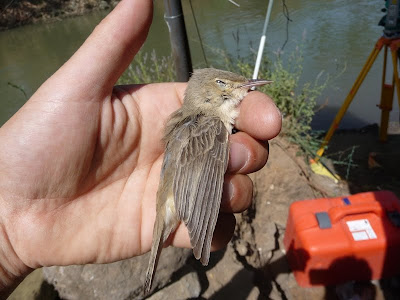
After saying farewell to Gadot, we headed back into the upper Galilee to stay at a friend’s house in a small hamlet called Matat. The views from here are amazing and the streets are lined with delicious fig and pomegranate trees – we had a good feed on these freebies. No new birds added, but this region gives a totally different experience of Israel – wooded, damp and cool.
Overall then, another great trip to Israel. The landscapes are often stunning, the people are very friendly and the wildlife is exceptional. For some reason people seem to single-out Israel for particular criticism without actually taking the trouble to go there, talk to people and find out about the place – the network of parks and reserves is most impressive and there are many good folk working hard for wildlife – they deserve support.

